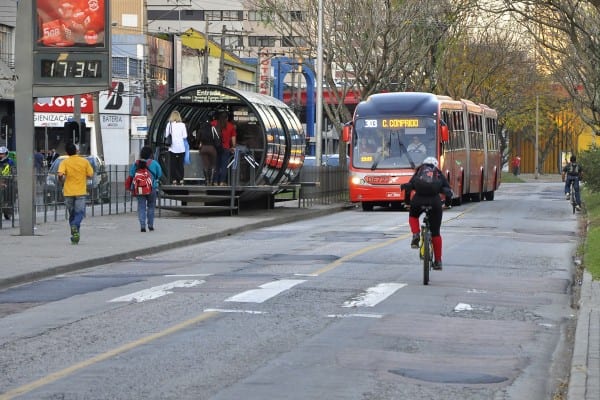
Curitiba’s Bus system with the elimination of private cars. Source: MBARQ Brasil | WRI Brasil Cidades Sustentáv (Flickr.com)
What if every time you properly disposed your waste, you got chocolate? In the city of Curitiba, Brazil, families who do not have access to a trash collection system can bring their waste to a neighborhood center in exchange for goods: bus tickets, food, school supplied, and even chocolate. This “Garbage That’s Not Garbage” program was so successful that 70% of the city’s trash was recycled by its residents. Curitiba’s success story is shared in Voula B. Mega’s book, Sustainable Cities for the Third Millennium: The Odyssey of Urban Excellence. In this book, Mega shares her expertise on European and global sustainable development policies and programs, which are gathered from her 15 years of service at the European Commission.
The book jumps from Copenhagen to Tokyo to Curitiba to highlight sustainable urban practices in cities all around the world. The case studies are united by a key principle: they incorporate cultural, environmental, and economic dimensions. Mega argues that strategies with two or more of those dimensions have lasting impact.
Mega advocates strongly for such mutually beneficial programs: “By analogy to the biological concentration of species in a mutually supportive environment, humans come together in places that optimize their reciprocal benefits.” Cities are intended to enact transformative change by maximizing the potential for synergies through partnerships. This is what Curitiba has done. The money from the recycled materials allowed the city to hire the homeless and recovering alcoholics for the waste separation plant. These efforts led to cleaner waterways and streets, as well as improved the local health. The synergy between the waste plant and residents encourages partners to cooperate, instead of oppose.
By analogy to the biological concentration of species in a mutually supportive environment, humans come together in places that optimize their reciprocal benefits.
Curitiba’s waste program is also successful because it collaborated with another city department. The Curitiba waste system also supports public transportation by trading waste and bus tickets. . Curitiba’s bus system is in fact praised for its efficiency. It is designed so well that 85% of the population uses public transportation. It does this with a bus system designed to function as a metro system. The long buses can fit 270 passengers, equipped with disability access, and travel on lanes solely dedicated for buses. Mega uses Curitiba to argue that the second major aspect of a transformative policy is mobility. Mobility is core to a city, and increasing convenient, affordable, and reliable transportation will benefit environmental and human health.
Curitiba further improved its mobility by eliminating private cars in the city center which enriched the city’s heart, and enhanced the ability of its public bus system to conveniently bring people to and from the center. This policy led to uncongested roads, air pollution reduction, and cultural pride. This pride translated into an annual tradition where children paint the paving stones on the road to mark the day when private cars were banned. This pride enhances the sense of community which increases the longevity of the change. Hence, the third lesson is innovation and celebration through people and the arts. Mega argues innovation come from people and their hope, which is the catalyst for change.
It is clear Mega’s knowledge is rich and vast. There are a few things she could change in her book. The misleading chapter titles along with the overwhelming number of case studies leaves the reader confused and disheartened. Every other paragraph in the book is a case study; hence, the full story of each city is dispersed throughout the book. The reader must navigate through the book to extract their own coherent case.
Sustainable Cities for the Third Millennium is a good resource for readers investigating current urban sustainability policies, however, they must know what they want going in. The abundant case studies distracts the reader from Mega’s arguments, however, that does not undermine Mega’s vision. Through her countless examples, Mega informs us that we can have the best of all worlds. Cities for humans and cities for nature are not mutually exclusive; rather, they need to come together to design better environments.